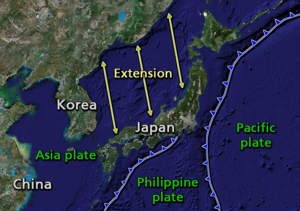Our website is made possible by displaying online advertisements to our visitors.
Please consider supporting us by disabling your ad blocker.
Geology of Japan

The islands of Japan are primarily the result of several large ocean movements occurring over hundreds of millions of years from the mid-Silurian to the Pleistocene, as a result of the subduction of the Philippine Sea Plate beneath the continental Amurian Plate and Okinawa Plate to the south, and subduction of the Pacific Plate under the Okhotsk Plate to the north.
Japan was originally attached to the eastern coast of the Eurasian continent. The subducting plates, being deeper than the Eurasian plate, pulled Japan eastward in the process of back-arc extension, opening the Sea of Japan around 15 million years ago.[1] The Strait of Tartary and the Korea Strait opened much later.
Japan is situated in a volcanic zone on the Pacific Ring of Fire. Frequent low intensity earth tremors and occasional volcanic activity are felt throughout the islands. Destructive earthquakes, often resulting in tsunamis, occur several times per century. The most recent major quakes include the 2024 Noto earthquake, the 2011 Tōhoku earthquake and tsunami, the 2004 Chūetsu earthquake, and the Great Hanshin earthquake of 1995.

- ^ Barnes, Gina L. (2003). "Origins of the Japanese Islands: The New "Big Picture"" (PDF). University of Durham. Archived from the original (PDF) on April 28, 2011. Retrieved August 11, 2009.
Previous Page Next Page


